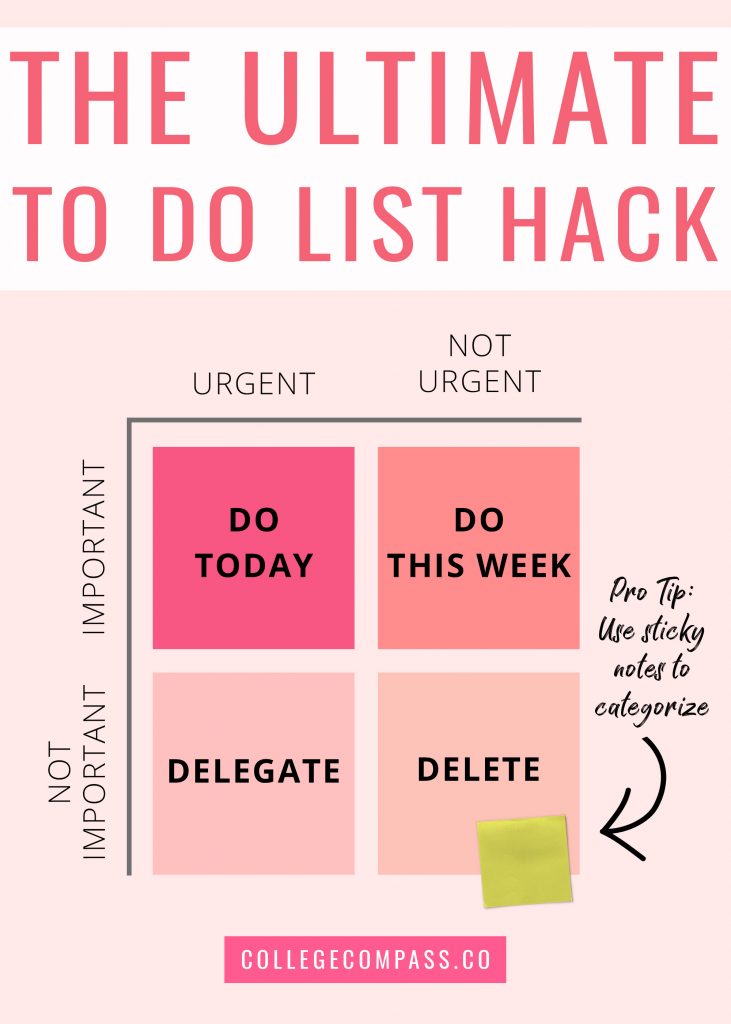I was recently reading about productivity when I came across a really interesting idea. It’s technically called the Eisenhower Matrix, inspired by a quote attributed to the famously productive president Dwight D. Eisenhower: “I have two kinds of problems, the urgent and the important. The urgent are not important, and the important are never urgent.” But because those aren’t his words and “matrix” makes this all sound very intimidating, I’m going to call it something else: the best to do list hack you’ll ever find.
Understanding Which Tasks Matter

This productivity “matrix” or organizer is cut into four cubes.
The first area is for items that are important to you and urgent. For example, if you need to write a paper for a class you love, or you’re expected at a meeting for a club you’re excited about, those things would go in Quadrant 1.
Quadrant 2 is for things that aren’t urgent but are important: things like exercising, learning an instrument or a new language, reading, or watching Parks and Rec with your best friends.
Quadrant 3 is for things that are urgent, but not important: things that need to get done but don’t necessarily need to be done by you, or won’t contribute to your success.
And Quadrant 4 is for time-sucks: things that don’t matter to you and aren’t urgent, like reading about conspiracy theories on Wikipedia, or watching a Youtube playlist of interviews with Taylor Swift from 2007.
Unproductive people, or people who procrastinate, tend to spend most of their time in Quadrants 3 and 4, doing tasks they don’t really enjoy and that aren’t important. Productive people spend most of their time in Quadrant 1, doing things that they need to do, and in Quadrant 2, doing things they want to do that help them grow as people.
What to Do About Each Task
There’s an easy principle to apply to this matrix: Do, Decide, Delegate (or Deal), and Delete.
Do the tasks in Quadrant 1, things that are important and urgent. It’s best to do these things today.
Decide about the tasks in Quadrant 2, tasks that are important but not urgent. You can decide when to do them this week.
Delegate the tasks in Quadrant 3, or deal with them. If you can ask for help or delegate these tasks to someone else, that’s great. If not, suck it up and deal with them in the short-term. The sooner they’re out of the way, the better!
Delete the tasks in Quadrant 4, which aren’t important or urgent. These shouldn’t be eating up your time; if you need a break and want to be productive, it’s much better to do Quadrant 2 tasks, things that make you happy and aren’t stressful or urgent.
Here’s a simple chart that you can pin on Pinterest to remember. You can also print this out, if you like!

How to Use This Today
Whether or not you’re a chronic procrastinator, you can use this principle to help you structure your to do list for efficiency and productivity. All you need is a piece of paper, a marker, and some sticky notes. If you like, you can also sign up for my mailing list to get this delivered to you as a printable!


This is my personal to do list organizer. If you want to decorate yours like mine, here are the tools I used! (The following links are affiliate links. Please read my affiliate disclosure for more info!)
- A thick black marker
- A few highlighters in different colors
- Some decorative washi tape
- Simple sticky notes

I divided my paper into four quadrants and marked the columns as “urgent” and “not urgent” and the rows as “important” and “not important. Then I wrote out each of my to do’s on a sticky note and stick them in the different categories to decide when to do them.
Again, the trick is to:
Do the tasks in Quadrant 1 today.
Decide about the tasks in Quadrant 2 this week.
Delegate or deal with the tasks in Quadrant 3.
Delete the tasks in Quadrant 4.

Using this trick will save you a lot of time and frustration when it comes to figuring out which of your to do’s to tackle when.
Had you heard of this trick before? Will you use it now? Let me know in the comments!




Trackbacks/Pingbacks